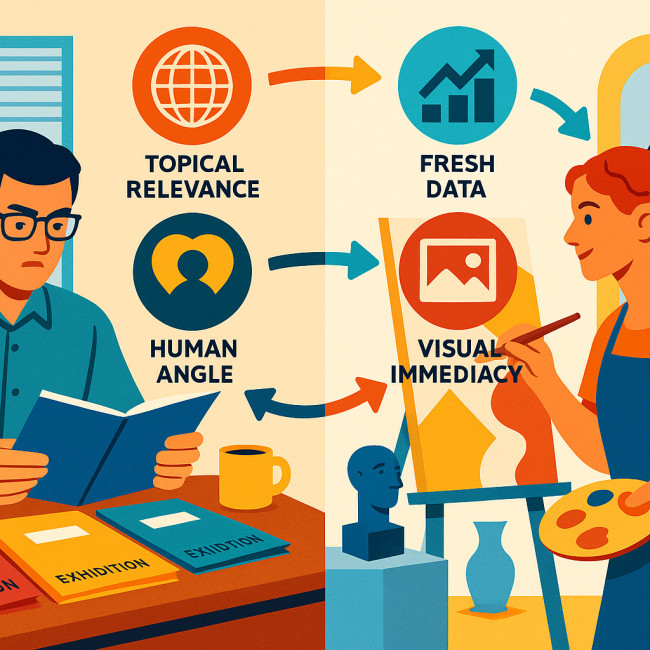Media outreach before a vernissage: craft stories journalists want to cover
Securing press buzz ahead of your exhibition opening is less about blasting a press release and more about pitching irresistible narratives. In this guide you will learn how to uncover angles journalists crave, package data and visuals that ease their workload, and time your follow-ups so your vernissage becomes the headline rather than a diary filler.
1. Understand what makes an arts story newsworthy in 2024

Editors receive dozens of exhibition pitches daily, yet only a handful make it to print or prime online slots. Based on recent newsroom surveys, four pillars decide whether your vernissage coverage request lands in the “yes” pile: topical relevance, human angle, fresh data, and visual immediacy. When budgets shrink and column inches tighten, editors lean on stories that promise clear reader value; therefore, your pitch must demonstrate why the show matters now, how it advances ongoing debates, and where it diverges from the flood of post-lockdown exhibition announcements to earn precious media real estate.
- Topical relevance – does the work connect to a current social, economic or environmental debate?
- Human angle – is there a compelling artist journey, community collaboration or personal transformation?
- Fresh data – can you provide exclusive figures or research to back the narrative?
- Visual immediacy – do you supply publish-ready photos, captions and short clips that fit multiple aspect ratios?
Source : Press Outreach Insights 2024
2. Map the narrative sweet spot between your art and the news cycle
2.1 List themes already dominating headlines
Scan cultural desks, podcast episodes and arts newsletters two months before your opening. Jot down repeated buzz-words—think “AI ethics,” “post-pandemic urbanism,” or “water scarcity.” Aligning even one series in your show with a trending keyword instantly raises the relevance score.
2.2 Connect personal process to macro issues
Journalists love bridging intimate studio moments with global conversations. Example: if you fire ceramics with locally sourced clay, link the technique to sustainable supply chains. That connection can slot into broader climate coverage and widen your potential readership.
2.3 Stress exclusivity
Offer a data point, first-look image or interview angle only available to one outlet. Scarcity nudges editors to act fast before a competitor claims the scoop.
3. Build an outreach toolkit journalists can publish instantly
A solid press kit is more than text; it's a time-saver for overstretched editors. Include:
| Asset | Specs journalists expect | Pro tip |
|---|---|---|
| Press release | ≤ 500 words, third-person, quotes in italics | Add a 30-word summary at top |
| Hi-res images | 300 dpi & 150 dpi, CMYK & RGB | Embed IPTC captions to cut editor workload |
| Caption sheet | Filename, artwork title, medium, price | Mirror alt-text for SEO wins |
| Artist bio | First person & third person versions | Link to full CV for depth seekers |
| Fact sheet | Key dates, venue map, social handles | Add QR code for fast mobile scan |
| B-roll video | ≤ 90 sec, 16:9 & 9:16 | Include silent version for narration overlays |
For a deeper dive into media kit essentials, explore our dedicated guide.
4. Segment your media list for laser-focused pitching
4.1 Prioritise by readership overlap
Match outlet audience data with your collector demographics. A niche design blog with 15 000 loyal readers may drive more footfall than a national broadsheet whose arts section skews outside your market.
4.2 Tailor subject lines
A/B test two framing angles: process-led vs. issue-led. Track open rates and refine. Example: “From river silt to gallery wall: sustainable clay sculptures debut” outperforms generic “Artist exhibition press release.”
4.3 Use embargoes strategically
Grant trusted journalists early access under embargo to give them time for deeper coverage, then release a broader announcement 48 hours later.
5. Timing: the 21-day countdown framework
- D-21: Send personalised pitch to tier-1 outlets; offer interview slots.
- D-14: Dispatch full press kit to tier-2 blogs and podcast hosts.
- D-7: Remind confirmed journalists; share update on sold works or added performances.
- D-2: Provide arrival logistics, parking codes, and live photo opportunities.
- D+1: Deliver high-resolution event images and sales highlights while buzz is fresh, a tactic echoed in our post-opening follow-up blueprint.
6. Strengthen your pitch with external validation
Third-party endorsements elevate trust fast. Consider:
- Referencing limited studies by art-driven advertising specialists to quantify audience engagement.
- Quoting curators or academics who reviewed your work in advance.
- Citing relevant data dashboards—e.g., footfall projections tied to local cultural events.
7. Leverage multimedia teasers on social channels
Short vertical reels showcasing installation progress often trigger journalist DMs requesting exclusives. Tagging local art correspondents in Stories accelerates discovery. Ensure captions echo press release keywords for seamless search alignment.
8. On-site press moments that make filing easier
Dedicate a quiet corner with Wi-Fi, power outlets and a labelled backdrop for quick interviews. Offer a 15-minute curator walk-through before doors open so reporters gather quotes without audience noise.
9. Common pitfalls to avoid
- Attachment overload – send download links, not 25 MB emails.
- Generic salutations – mass “Dear Editor” messages tank your credibility.
- Missing alt-text – visuals without descriptions lower accessibility scores and SEO value.
- Late responses – journalists operate on tight deadlines; a 24-hour reply lag can kill a story.
Your outreach readiness quiz
FAQ
- How long should my press release be?
- Keep it under 500 words with a 30-word abstract so editors grasp the hook instantly.
- Is paid advertising necessary for media coverage?
- No. Strong story angles and personalised pitches often outperform paid placements. However, pairing outreach with targeted ads can amplify reach.
- What if I have no controversial angle?
- Focus on process insights, community impact, or exclusive data to retain relevance without manufacturing controversy.
- Should I invite influencers as well as journalists?
- Yes, but separate their experience—offer shareable photo ops without diluting press interview slots.
Next steps
Ready to turn your vernissage into the cultural talking point of the month? Combine the framework above with our annual art-event planning roadmap and virtual exhibition essentials to keep momentum long after opening night.
Call to action: Download the free checklist “21-day press outreach sprint” and receive a weekly tip on sustaining editor relationships all year.











